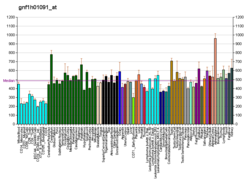WNT3A
WNT3A(Wnt family member 3A)は、ヒトではWNT3A遺伝子にコードされるタンパク質である[5]。
WNT遺伝子ファミリーは、分泌型シグナル伝達タンパク質をコードする、構造的に関連した遺伝子から構成される。これらのタンパク質は、組織の恒常性、胚発生、疾患に重要である。
シグナル伝達と関連遺伝子
[編集]WNT3Aは、配列と機能の双方でWNT3ときわめて関連性が高い。WNT3AとWNT3はどちらも主にβ-カテニン/Tcf経路を介してシグナルを伝達する。多くの脊椎動物で、WNT3A遺伝子はWNT9A遺伝子とゲノム上で並んで位置している。同様に、WNT3遺伝子はWNT9B遺伝子と並んで位置している。WNT9AとWNT9Bはβ-カテニン/Tcf経路を介してシグナルを伝達するが、WNT3AとWNT3のように同じ細胞過程に関係した役割を果たしているわけではない。
疾患における役割
[編集]ヒトでは、WNT3Aは特定の遺伝疾患とは関係していない。Wnt-3aに遺伝的変異を抱えるマウスは胚発生初期に致死となり、沿軸中胚葉の形成過程に欠陥が生じる[6]。WNT3Aは腫瘍誘発性のβ-カテニン/Tcf経路を促進するため、特定の細胞集団で発現した際にはがんを引き起こす[7]。
胚発生における役割
[編集]胚発生とは、ボディプランを形成する過程である。脊椎動物モデル系での研究から、ヒトの解剖学的構造における特定の遺伝子の役割を推測することができる。WNT3Aは次に挙げる過程と関係している。
胴体
[編集]WNT3Aは、胴体領域の神経、筋肉、骨、軟骨を形成する多能性幹細胞集団に対してパターン形成を行う。WNT3Aはこれらの多能性幹細胞に対し、神経ではなく、筋肉、骨、軟骨の前駆細胞を形成するように指示を出す[8]。また、WNT3AはNotch経路も調節し、正常な胴体発生に必要な分節時計(segmentation clock)を制御する[9][10]。
左右パターン形成
[編集]WNT3Aは、左側シグナルの決定因子であるNODAL遺伝子を活性化するシグナル伝達経路に関与する[11]。
結腸
[編集]消化管の結腸部分の形成はWNT3Aに完全に依存しており、WNT3Aは結腸前駆細胞の成長を選択的に引き起こす[12]。
神経堤
[編集]血液細胞
[編集]WNT3Aは造血幹細胞の自己複製を促進する。WNT3Aは骨髄細胞の発生に必要であるがB細胞の発生には必要なく、また未熟胸腺細胞の分化に影響を与える[14]。
海馬
[編集]歯
[編集]出典
[編集]- ^ a b c GRCh38: Ensembl release 89: ENSG00000154342 - Ensembl, May 2017
- ^ a b c GRCm38: Ensembl release 89: ENSMUSG00000009900 - Ensembl, May 2017
- ^ Human PubMed Reference:
- ^ Mouse PubMed Reference:
- ^ “Entrez Gene: WNT3A wingless-type MMTV integration site family, member 3A”. 2022年10月2日閲覧。
- ^ “Evidence that absence of Wnt-3a signaling promotes neuralization instead of paraxial mesoderm development in the mouse”. Developmental Biology 183 (2): 234–42. (March 1997). doi:10.1006/dbio.1997.8502. PMID 9126297.
- ^ “Role of Wnt3a in the pathogenesis of cancer, current status and prospective”. Molecular Biology Reports 46 (5): 5609–5616. (October 2019). doi:10.1007/s11033-019-04895-4. PMID 31236761.
- ^ “Lineage tracing of neuromesodermal progenitors reveals novel Wnt-dependent roles in trunk progenitor cell maintenance and differentiation”. Development 142 (9): 1628–38. (May 2015). doi:10.1242/dev.111922. PMC 4419273. PMID 25922526.
- ^ “Wnt3a plays a major role in the segmentation clock controlling somitogenesis”. Developmental Cell 4 (3): 395–406. (March 2003). doi:10.1016/s1534-5807(03)00055-8. PMID 12636920.
- ^ “Wnt3a links left-right determination with segmentation and anteroposterior axis elongation”. Development 132 (24): 5425–36. (December 2005). doi:10.1242/dev.02149. PMC 1389788. PMID 16291790.
- ^ “Wnt3a links left-right determination with segmentation and anteroposterior axis elongation”. Development 132 (24): 5425–36. (December 2005). doi:10.1242/dev.02149. PMC 1389788. PMID 16291790.
- ^ “A dorsal-ventral gradient of Wnt3a/β-catenin signals controls mouse hindgut extension and colon formation”. Development 147 (8): dev185108. (April 2020). doi:10.1242/dev.185108. PMC 7174843. PMID 32156757.
- ^ “A dorsal-ventral gradient of Wnt3a/β-catenin signals controls mouse hindgut extension and colon formation”. Development 147 (8): dev185108. (April 2020). doi:10.1242/dev.185108. PMC 7174843. PMID 32156757.
- ^ “Wnt3a deficiency irreversibly impairs hematopoietic stem cell self-renewal and leads to defects in progenitor cell differentiation”. Blood 113 (3): 546–54. (January 2009). doi:10.1182/blood-2008-06-163774. PMID 18832654.
- ^ “A local Wnt-3a signal is required for development of the mammalian hippocampus”. Development 127 (3): 457–67. (February 2000). PMID 10631167.
- ^ “Wnt-3a Induces Epigenetic Remodeling in Human Dental Pulp Stem Cells”. Cells 9 (3): E652. (March 2020). doi:10.3390/cells9030652. PMC 7140622. PMID 32156036.
関連文献
[編集]- “Wnt family proteins are secreted and associated with the cell surface”. Molecular Biology of the Cell 4 (12): 1267–75. (December 1993). doi:10.1091/mbc.4.12.1267. PMC 275763. PMID 8167409.
- “Differential expression of human Wnt genes 2, 3, 4, and 7B in human breast cell lines and normal and disease states of human breast tissue”. Cancer Research 54 (10): 2615–21. (May 1994). PMID 8168088.
- “Human frizzled 1 interacts with transforming Wnts to transduce a TCF dependent transcriptional response”. Oncogene 18 (44): 5959–66. (October 1999). doi:10.1038/sj.onc.1202985. PMID 10557084.
- “The evolutionarily conserved porcupine gene family is involved in the processing of the Wnt family”. European Journal of Biochemistry 267 (13): 4300–11. (July 2000). doi:10.1046/j.1432-1033.2000.01478.x. PMID 10866835.
- “Regulation of WNT3 and WNT3A mRNAs in human cancer cell lines NT2, MCF-7, and MKN45”. International Journal of Oncology 20 (2): 373–7. (February 2002). doi:10.3892/ijo.20.2.373. PMID 11788904.
- “Molecular cloning and expression of mouse Wnt14, and structural comparison between mouse Wnt14-Wnt3a gene cluster and human WNT14-WNT3A gene cluster”. International Journal of Molecular Medicine 9 (3): 221–7. (March 2002). doi:10.3892/ijmm.9.3.221. PMID 11836627.
- “Wnt-3A/beta-catenin signaling induces transcription from the LEF-1 promoter”. The Journal of Biological Chemistry 277 (36): 33398–410. (September 2002). doi:10.1074/jbc.M107977200. PMID 12052822.
- “Direct interaction of Frizzled-1, -2, -4, and -7 with PDZ domains of PSD-95”. FEBS Letters 521 (1-3): 185–9. (June 2002). doi:10.1016/S0014-5793(02)02831-4. PMID 12067714.
- “Generation and initial analysis of more than 15,000 full-length human and mouse cDNA sequences”. Proceedings of the National Academy of Sciences of the United States of America 99 (26): 16899–903. (December 2002). doi:10.1073/pnas.242603899. PMC 139241. PMID 12477932.
- “Casein kinase I epsilon enhances the binding of Dvl-1 to Frat-1 and is essential for Wnt-3a-induced accumulation of beta-catenin”. The Journal of Biological Chemistry 278 (16): 14066–73. (April 2003). doi:10.1074/jbc.M213265200. PMID 12556519.
- “Wnt signaling in B-cell neoplasia”. Oncogene 22 (10): 1536–45. (March 2003). doi:10.1038/sj.onc.1206239. PMID 12629517.
- “Regulation of the Wnt signaling pathway by disabled-2 (Dab2)”. The EMBO Journal 22 (12): 3084–94. (June 2003). doi:10.1093/emboj/cdg286. PMC 162138. PMID 12805222.
- “A novel mechanism for Wnt activation of canonical signaling through the LRP6 receptor”. Molecular and Cellular Biology 23 (16): 5825–35. (August 2003). doi:10.1128/MCB.23.16.5825-5835.2003. PMC 166321. PMID 12897152.
- “Regulation of casein kinase I epsilon activity by Wnt signaling”. The Journal of Biological Chemistry 279 (13): 13011–7. (March 2004). doi:10.1074/jbc.M304682200. PMID 14722104.
- “The low density lipoprotein receptor-1, LRP1, interacts with the human frizzled-1 (HFz1) and down-regulates the canonical Wnt signaling pathway”. The Journal of Biological Chemistry 279 (17): 17535–42. (April 2004). doi:10.1074/jbc.M311292200. PMID 14739301.
- “Mammalian Ryk is a Wnt coreceptor required for stimulation of neurite outgrowth”. Cell 119 (1): 97–108. (October 2004). doi:10.1016/j.cell.2004.09.019. PMID 15454084.
- “Processing by convertases is not required for glypican-3-induced stimulation of hepatocellular carcinoma growth”. The Journal of Biological Chemistry 280 (50): 41201–6. (December 2005). doi:10.1074/jbc.M507004200. PMID 16227623.
- “Activation of intracellular calcium by multiple Wnt ligands and translocation of β-catenin into the nucleus: a convergent model of Wnt/Ca2+ and Wnt/β-catenin pathways”. The Journal of Biological Chemistry 288 (50): 35651–9. (December 2013). doi:10.1074/jbc.M112.437913. PMC 3861617. PMID 24158438.





